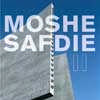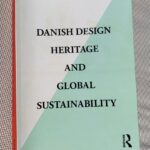Moshe Safdie Book, Architecture Monograph, Essays, Work, Design, News
Moshe Safdie Book : Practice Monograph
Architecture Publication Launched : work from 1996-2008
Second monograph, Moshe Safdie II, published by the practice.
The monograph contains a collection of work from 1996-2008
MOSHE SAFDIE II by Moshe Safdie
Essays by William J. Mitchell and Thomas Fisher
Edited by Diana Murphy
11 Aug 2009
Moshe Safdie II Book
As a global practice, Moshe Safdie and Associates has been widely lauded for capturing the character and symbolism of place as well as the construction of powerful, even redemptive narratives in architecture. Deserving equal recognition, however, is Mr. Safdie’s investigative spirit that drives the design process and programmatic innovation.
Moshe Safdie II begins with an essay by Mr. Safdie on the themes of ethics, order and complexity. Citing Louis Kahn’s famous dictum “let the building be what it wants to be”, Safdie suggests that a search for the most appropriate interpretation of a program is one of the greatest sources of invention in architecture. This second volume demonstrates Safdie’s embrace of design strategies in service of transforming urban experience and to humanize and affirm the identity of the individual within the whole. These strategies include mitigating mega scale by breaking down the large scale into a series of comprehensible parts, orienting users through familiar views and landmarks, deploying clearly differentiated public gathering spaces called “urban rooms”, as well as site-specific interventions seeking to merge site and infrastructure as a constellation of elements.
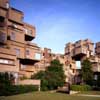
Habitat 67 photo © Timothy Hursley
In an essay by William J. Mitchell, Safdie’s career of over forty years is placed in the context of high speed jet travel’s “dualities, displacements and multiple connections” and is evident in his characteristic sensibility that finds extraordinary varied expression “highly inflected to their circumstances”. Described as a culturally agile fusion chef with modernist faith in the poetic power of rigorous abstraction, Mitchell provides insight into Safdie’s interest in the logic of building blocks operating at the unstable intersections of the local and global; tradition and modernity.
Holocaust History Museum at Yad Vashem, Jerusalem, Israel
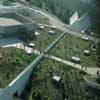
photo © Timothy Hursley
In his essay Thomas Fisher points out that Safdie’s buildings have been opportunities to test his ideas in the books, just as the publications no doubt emerged from experiences constructing the buildings. Written with serious intent and a sense of urgency, they anticipated the sustainability movement and continue to be relevant, advocating a respectful and reciprocal relationship with the natural world.
Featured Projects include the United States Institute of Peace Headquarters in Washington, D.C; a renovation and addition to the Free Library of Philadelphia; Holocaust History Museum at Yad Vashem, Jerusalem, Israel; the New City of Modi’in, Israel; the Khalsa Heritage Memorial Complex in Punjab, India; the Yitzhak Rabin Center in Tel Aviv, Israel; the Salt Lake City Public Library in Salt Lake City, Utah; the Kauffman Center for the Performing Arts in Kansas City, Missouri; the Crystal Bridges Museum of American Art in Bentonville, Arkansas; and Marina Bay Sands, an integrated resort in Singapore.
Salt Lake City Public Library, Salt Lake City, Utah, USA
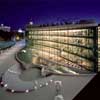
photo © Timothy Hursley
Originally published in 1996, Moshe Safdie Volume I with critical essays by Peter Rowe, Witold Rybczynski, Paul Goldberger and Michael Sorkin has been re-released by Images Publishing Group.
Moshe Safdie and Associates
Moshe Safdie first established his architectural practice in 1964 in Montreal, Canada to design and supervise the construction of Habitat 67. Today the international practice of Moshe Safdie and Associates maintains a principal office in Boston, Massachusetts and branch offices in Jerusalem, Toronto, and Singapore. The firm provides a full range of urban planning, architectural and interior design services to clients ranging from public institutions to private organizations and non-profits.
Every project undertaken by Moshe Safdie and Associates is designed personally by Moshe Safdie, who is supported by a diverse team experienced in the development and execution of complex buildings. Together they effectively utilize a host of resources to create buildings that are unified expressions of their technologies and construction materials, as well as their settings and purpose.
Khalsa Heritage Memorial Complex, Anandpur Sahib, Punjab, India
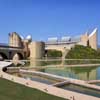
photo © Ram Rahman
About the Essay Writers
William J. Mitchell (Building in a Networked World)
William J. Mitchell is director of the MIT Design Laboratory, holds the Alexander W. Dreyfoos, Jr. Professorship and directs the MIT Media Lab’s Smart Cities research group. He was formerly dean of the School of Architecture and Planning and head of the Program in Media Arts and Sciences, both at MIT. Other previous posts have included the Travelstead Professor of Architecture and Director of the Master in Design Studies program at Harvard’s Graduate School of Design and head of the Architecture/Urban Design program at UCLA’s Graduate School of Architecture and Urban Planning.
Thomas Fisher, FAIA (The Books Behind the Buildings)
Thomas Fisher, FAIA is Professor and Dean at the University of Minnesota’s College of Design. His research revolves around the relationship between the history of ideas and the design and production of architecture. A recent focus has been on the ethical, economic, and cultural ideas that drive unsustainable building practices in the United States. He also remains active as an architectural critic, writing frequently for professional journals and general-interest publications.
Architectural Design
Architecture Walking Tours in Europe : city walks by e-architect
Architecture Design Books – chronological list of publications
Marina Bay Sands Integrated Resort, Singapore

photo © John Horner
Contemporary Architecture Books
Comments / photos for the Moshe Safdie II Practice Monograph page welcome

